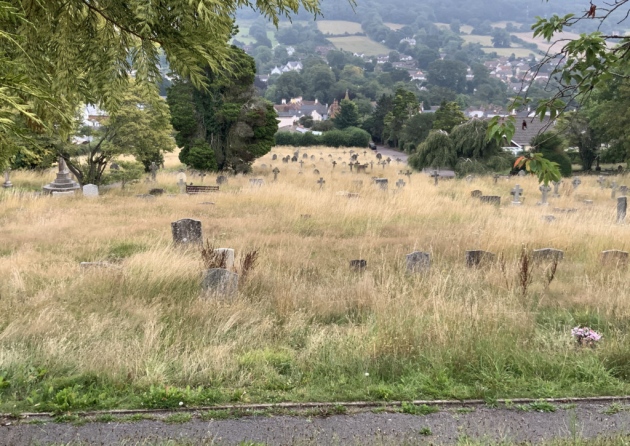“Beauty is in the eye of the beholder.” [Facebook comment]
.
In August 2020, there were complaints about areas of the Sidmouth Cemetery gone wild. This prompted the Sid Valley Biodiversity Group to conduct a survey – and a new ‘sensitive plan’ was proposed.
All of this is very much in the eye of the beholder – with this photo taken at the time:

The District Council put the plan into place, with their maintenance regime:
Our dedicated teams from Streetscene care for our Cemeteries at Seaton, Sidbury and Sidmouth, which are owned by EDDC as well as 10 closed churchyards, parks and gardens, doing all the grounds maintenance to keep your open spaces clean and green. Sidmouth & Seaton cemeteries are Nature Recovery sites within East Devon
However, it doesn’t seem to be working – or at least some people don’t think it’s working – with a long discussion thread today on the Sidmouth Community facebook pages, starting with this heartfelt comment:
I visit Sidmouth most years from Sussex remembering the times I spent here with my grandparents in the late 1950s. I’m appalled at the state of the lower cemetery under the guise of rewilding aka cost saving. If I didn’t know the location of my grandfather’s grave it would be impossible to find it. Nothing is done, to the extent that paths are breaking up. Surely this cannot be justified
In response, Ed Dolphin suggests:
On the other hand there are plenty of people delighted to see the celebration of God’s creation such as the butterflies whose caterpillars are now hibernating underground ready to emerge in the spring. There could be some tweaks such as cutting paths but I like it as it is. Beauty is in the eye of the beholder...
Buddleias bring in some adult butterflies such as red admirals and peacocks, but the caterpillars need nettles to feed on, no nettle, no butterflies to feed on the buddleias. The small coppers, ringlets, gatekeepers and meadow browns that were recorded in there during the Big Butterfly Count need the long grass for their caterpillars, as do the grasshoppers and crickets. The burnet moths need bird’s-foot trefoil for the caterpillars and knapweed and thistle for the adults. Rats and mice do not use the long grass generally, they will be living under the garden sheds next door. As for the look, beauty is in the eye of the beholder.
…